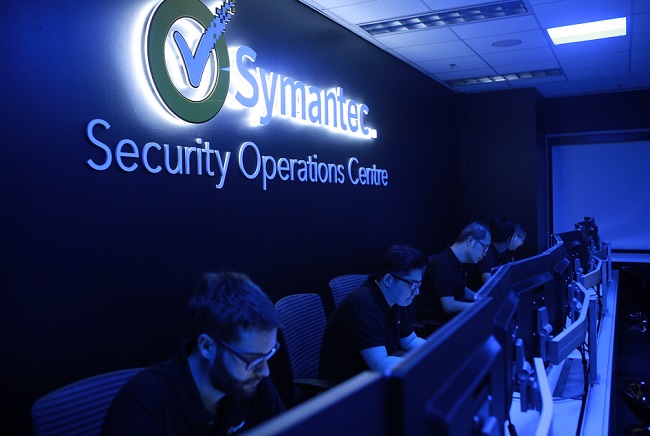Symantec’s future guided by four priorities, says senior exec
By Benjamin Cher December 10, 2015
- Shifting towards the cloud and becoming a service provider
- Launches Security Operations Centre in Singapore

THE road behind Symantec Corp has been a happily eventful one, from the sale of its Veritas business for a whopping US$8 billion to being named one of the top 100 global innovators by Thomson Reuters.
The road ahead, however, is what’s important, and this will be guided by four priorities, according to Sanjay Rohatgi (pic above), its senior vice president of Asia Pacific and Japan.
“The first [priority] is delivering our unified security strategy, which encompasses four pillars: Threat protection, information protection, cybersecurity services, and unified security analytics,” he told the media in Singapore recently.
“As the threat landscape evolves to be more targeted, advanced and malicious, Symantec is well positioned to help its customers,” he added.
The focus on security will lead to a doubling down on enterprise security, which leads to the second priority: That of building an enterprise security pipeline.
“Quarter on quarter, we see our pipeline improving, and the focus has brought about good stuff with it,” Sanjay declared.
“We have been leveraging on our partners quite a bit, and this has helped in building our enterprise security business in a holistic way,” he added.
The third priority for Symantec is in improving its cost structure, with realistic targets being set.
“Our CEO [chief executive officer Michael A. Brown] has said that our long-term aim is to reach a 30% operating margin, and our last quarter was within 27% to 28%, which is not far,” Sanjay said.
“However, as we split the two companies, Veritas and Symantec, we will have some legacy costs which The Carlyle Group [Veritas’ buyer] does not want,” he said, adding that the 30% operating margin target would then probably take up to six quarters to achieve.
The fourth and final priority is to “deploy capital to maximise shareholder value.”
“We are going to give about US$1.5 billion dollars back,” Sanjay said, referring to a share repurchase programme.
READ ALSO: Security: 3 things to know, 3 things to do
Cloud and innovation shift
In August, Symantec said it was selling its information management division Veritas to an investor group led by The Carlyle Group for US$8 billion in cash. The transaction is expected to close by Jan 1, 2016.
The Veritas sale gives Symantec the opportunity for inorganic growth, building on its own organic innovation, according to Sanjay.
Wait, what?
“We are reliant on organic innovation right now, but with the money from the Veritas sale, we are going to inorganically grow as well, with a few acquisitions in the coming months,” he explained.
“We may be a little bit late in bringing our solutions to market, but we wanted to make sure that we cover all the three [areas]: Control vectors, threat vectors, and endpoints,” he added.
Symantec is now transitioning to offer security ‘as-a-Service,’ in line with customer needs.
“It is increasingly difficult to handle advanced threats,” said Sanjay. “When we meet our customers, they are asking if they can start outsourcing their entire security portfolio to us.”
“This transition will take some time, but what is available on-premises will also be available on the cloud, and the full transition should take 12 to 18 months,” he added.
And the four pillars of security mentioned earlier will be used as focal points for future growth and acquisitions.
“Anything we do from here on, these four pillars will guide our strategy, and any acquisitions will be along these lines too,” Sanjay said.
Asia Pacific scaling
The Asia Pacific region is one of the fastest growing regions for Symantec, with the total addressable market (TAM) valued at US$5.3 billion and a compound annual growth rate (CAGR) of 14% from fiscal 2015 to 2018.
“We are the only region in the world which is growing so fast, with double-digit growth across the board,” Sanjay said.
Symantec lists the Asean TAM as US$373 million. Its ‘Asean market’ includes not only South-East Asian countries such Indonesia, Malaysia, Myanmar, the Philippines, Singapore, Thailand, and Vietnam; but also Bangladesh, Nepal and Sri Lanka.
The reason for the company’s optimistic outlook on Asia Pacific is two-fold: “The adoption of cloud, social and mobile is much higher in this part of the world,” Sanjay said.
“Emerging countries here are leapfrogging and adopting the cloud much faster than anywhere else in the world,” he added.
The importance of the region is also reflected in the fact that one-third of Symantec’s employees are based in Asia Pacific, according to Sanjay.
“We have 1,800 research and development (R&D) employees in the region, which is roughly one in two R&D employees.
“We have four of the six global security operation centres (SOCs) here in the region, in Sydney, Tokyo, Chennai and Singapore; and three STARs (Symantec Track and Response Teams) based in Singapore, Tokyo and India,” he added.
New SOC

Sanjay was speaking to the media after Symantec launched its latest SOC in Singapore (pic above), as part of a US$50-million investment into security. The company declined to disclose how much of the investment went into the new SOC.
The Singapore SOC will be part of the network of global SOCs, and will help in serving customers in South-East Asia and China, according to the company. Another SOC in Europe is expected to come online within the next 12 months.
“There are about 85 people in the Singapore SOC and Security Response Centre,” said Symantec Cyber Security Services senior director Peter Sparkes.
“The SOC can take a threat intelligence feed and turn it into actionable insights within 10 minutes,” he added.
Localisation and having people on the ground were important factors leading to the company setting up an SOC in Singapore.
“The whole idea … is we want local people dealing with local clients in local hours,” Sparkes said.
“In the end, security is all about trust and the people connections, and that’s one of the reasons why we are in Tokyo, Sydney, Chennai and Singapore – to build those people connections,” he added.
Related Stories:
Cybercriminals more patient, eyeing bigger targets: Symantec
Symantec unveils new technologies to fight targeted attacks
Singtel and FireEye launch joint Advanced Security Operations Centre
For more technology news and the latest updates, follow us on Twitter, LinkedIn or Like us on Facebook.


